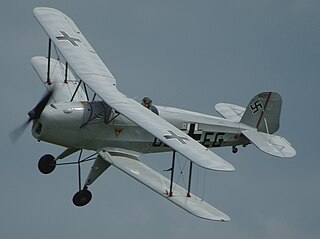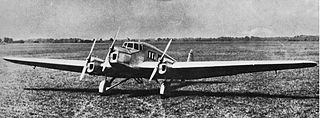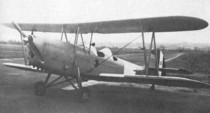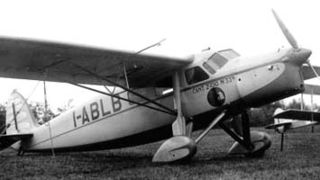
The Bücker Bü 131 Jungmann is a German 1930s basic training aircraft which was used by the Luftwaffe during World War II.

The Klemm Kl 35 is a German sporting and training aeroplane developed as a successor to the Kl 25. A product of Klemm Leichtflugzeugbau Gmbh it shared the same single-engine, cantilever low-wing configuration as the earlier machine, the major difference being the introduction of an inverted gull wing.

The Ambrosini SAI.7 was an Italian racing aircraft flown before World War II that entered production as a military trainer after the war. It was of conventional configuration, constructed of wood, with a tail-wheel undercarriage. Power was provided by an air-cooled, inverted inline engine, the Alfa-Romeo model 115 with 225 horsepower.

The Alfa Romeo 115 was an Italian six-cylinder air-cooled inverted inline engine for aircraft use, mainly for training and light planes, based on the de Havilland Gipsy Six engine. Production totalled approximately 1,600 units. Derivatives of the 115 include the -1, bis, ter and Alfa Romeo 116.

The Breda Ba.25 was an Italian two-seat biplane trainer designed and built by the Breda company. It was the most widely used Italian basic trainer of the 1930s.

The Caproni Ca.97 was a civil utility aircraft produced in Italy in the late 1920s and early 1930s. As originally designed, it was a high-wing braced trimotor monoplane of conventional configuration with one engine mounted on the nose and the other two carried on strut-mounted nacelles at the fuselage sides. Examples were also produced with only the nose engine or only the two nacelle-mounted engines.

The Fairchild 22 Model C7 was an American two-seat touring or training monoplane designed and built by the Kreider-Reisner division of the Fairchild Aircraft Corporation at Hagerstown, Maryland.

The Fiat G.2 was an Italian three-engine six-passenger monoplane transport aircraft designed by Giuseppe Gabrielli and built by Fiat.

The Nardi FN.305 was an Italian fighter trainer and liaison monoplane developed by the Fratelli Nardi company.
The Nardi FN.316 was an Italian advanced fighter trainer monoplane developed by the Fratelli Nardi company from the Nardi FN.305.

The Fiat G.46 was a military trainer developed in Italy shortly after World War II.

The Savoia-Marchetti S.59 was a 1920s Italian reconnaissance/bomber flying boat designed and built by Savoia-Marchetti for the Regia Aeronautica.

The SAIMAN 200 was a 1930s Italian two-seat primary trainer designed and built by the Società Industrie Meccaniche Aeronautiche Navali (SAIMAN).

The SAIMAN 202 was a 1930s Italian two-seat cabin monoplane designed and built by the Società Industrie Meccaniche Aeronautiche Navali (SAIMAN).

The CANT Z.1012 was a small three-engined monoplane built in Italy in the late 1930s to carry either three or five passengers depending on the engines. A small number were built for Italian diplomatic use.
The Tokyo Koku Ki-107 was a Japanese military training aircraft for the Imperial Japanese Army Air Force. The Ki-107 was a wooden-built low-wing two-seat monoplane with an open cockpit. Powered by a Hitachi Hatsukaze Ha-47 (Ha-11) inline piston engine it first flew in October 1943. The Japanese Army had ordered 450 as primary trainers as replacement for the Kokusai Ki-86, but production was held up by air raids and only 29 had been delivered by the end of the war.

The IAR-22 was a single engine basic trainer built in Romania in about 1934. It was a low-wing monoplane with two seats in tandem and a fixed conventional undercarriage.

The IAR 27 was a 1930s Romanian two-seat low-wing monoplane primary trainer designed and built by Industria Aeronautică Română.

The CANT Z.1010 was a single engine, five seat Italian passenger aircraft flown in the mid-1930s. Only one was built.

The Isotta Fraschini Beta was an air cooled aircraft engine produced by the Italian engineering company Isotta Fraschini in the 1940s. Isotta Fraschini derived the Beta inverted 6-cylinder in-line aircraft engine from the V-12 Gamma. The engine saw limited production for aircraft, including the Nardi FN.316 and Ambrosini SAI.7, but was generally unsatisfactory in service.



















